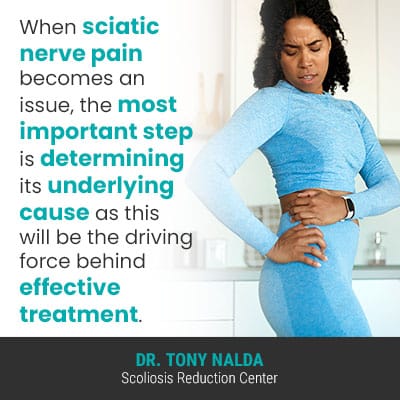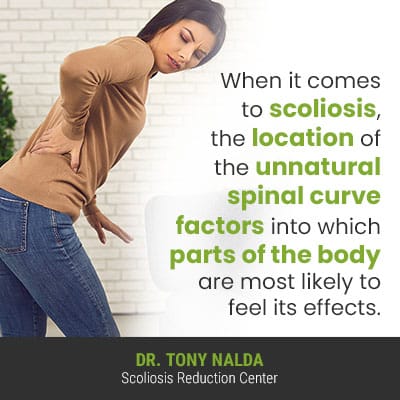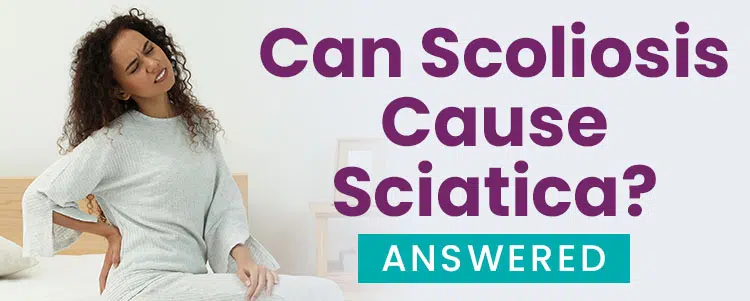There are multiple variables that come into play and shape the type of symptoms people with scoliosis experience, which is why there is no general answer regarding what to expect. When it comes to sciatic nerve pain, this is most likely to become an issue with lumbar scoliosis as the unnatural spinal curve develops in the lower back, where the sciatic nerve originates.
While sciatica isn’t a guaranteed complication of scoliosis, it is likely in cases of lumbar scoliosis. Due to uneven forces the condition introduces, it can cause the sciatic nerve to become pinched, compressed, or impinged and can affect the lower body’s range of motion.
Scoliosis, particularly if left untreated, can cause a myriad of effects felt throughout the body, including radicular pain in the lower body when the sciatic nerve is involved.
4 Key Takeaways
- Lumbar Scoliosis and Sciatica: Sciatica is more likely to occur in individuals with lumbar scoliosis due to the proximity of the sciatic nerve to the lower spine. The unnatural curvature can exert uneven pressure on the nerve, leading to sciatica symptoms.
- Understanding Sciatica Symptoms: Sciatica involves a range of symptoms from lower back pain to sensations of burning, tingling, or weakness along the sciatic nerve’s pathway. Its severity can vary based on the underlying cause and extent of nerve involvement.
- Diagnosing and Treating the Underlying Cause: Effective treatment for sciatica associated with scoliosis focuses on addressing the spinal curvature itself. By reducing the scoliotic curve, pressure on the sciatic nerve can be alleviated, mitigating sciatica symptoms.
- Comprehensive Scoliosis Management: A multi-disciplinary treatment approach that includes chiropractic care, targeted exercises, and potentially corrective bracing can effectively address the structural issues of scoliosis, offering long-term relief from sciatica caused by lumbar scoliosis.
What is Sciatica?
Contrary to popular opinion, sciatica is not a condition itself; more accurately, it refers to a set of symptoms.
When the sciatic nerve is exposed to uneven pressure, it can become pinched, compressed, or impinged.
The sciatic nerve is the largest in the human body, originating in the lower back and extending down the buttock, leg, and into the foot.
Most often, sciatica is felt on one side of the body, most commonly the left, less commonly the right, and rarely affects both sides.
The sciatic nerve is classified as a mixed nerve because it contains motor and sensory fibers, which is why it can affect the sensation and movement of the lower body.
When the sciatic nerve is exposed to uneven pressure, it can produce the following symptoms that can range from mild and intermittent to chronic and debilitating, depending largely on causation and the extent of nerve involvement:
- Lower back pain
- Pain in the back of the leg
- Hip pain
- Burning sensations in the leg
- Leg weakness
- Reduced range of motion in the leg
- Pain in the buttocks
- Shooting pain throughout the lower body
- Pain in the toes
- Bladder issues (severe cases)

When sciatic nerve pain becomes an issue, the most important step is determining its underlying cause as this will be the driving force behind effective treatment.
Let’s now move on to exploring the nature of scoliosis and the connection between scoliosis and Sciatica in more detail.
What is Scoliosis?
For a diagnosis of scoliosis to be given, certain parameters have to be met. The development of an unnatural sideways spinal curve has to include rotation, making it a 3-dimensional condition, and be of a certain size: Cobb angle measurement of 10+ degrees.
As the spine develops an unhealthy curve, its natural and healthy curves are lost, and its natural curves make it stronger, more flexible, and better able to absorb/distribute mechanical stress incurred during movement.
A loss of the spine’s healthy curves affects its overall function, biomechanics, and health.
Scoliosis can develop in any of the spine’s main sections: cervical (neck), thoracic (middle/upper back), and lumbar (lower back).
There are different types of scoliosis based on patient age, curvature location, condition severity, and causation; by extension, there are certain symptoms that are associated with these different variables.
Scoliosis is progressive, meaning it’s in its nature to worsen over time, particularly if left untreated or not treated proactively, which is why a focus of treatment is counteracting the condition’s progressive nature.
The more a condition progresses, the more complex it gets to treat, and the more limits there are to what we can achieve.
It’s important to understand that as the spine works in tandem with the brain to form the body’s central nervous system (CNS), and the spine is involved in virtually every working system within the body, which is why it can cause such a wide range of symptoms felt throughout the body.

When it comes to scoliosis, the location of the unnatural spinal curve factors into which parts of the body are most likely to feel its effects.
The more severe a condition gets, the more likely it is to cause complications, such as sciatic nerve pain, so let’s move on to the connection between scoliosis and sciatica.
Scoliosis and Sciatica
As mentioned, scoliosis is a complex condition that can cause many different effects felt throughout the body such as sciatic pain and neuropathy.
When it comes to scoliosis and sciatica, they are most closely related when it comes to lumbar scoliosis as this involves the lower body, where the sciatic nerve originates.
Most people have 33 spinal vertebrae (bones of the spine), five of which make up the lumbar spine.
The vertebrae of the lower back are often referred to as the stress vertebrae because not only does the lumbar spine have to support the weight of the entire trunk and the spinal sections above. It also feels the effects of bending, twisting, and turning motions while facilitating the lower body’s range of motion.
In fact, it’s thought that most people, at some point in their lives, will experience lower back pain as it’s the spinal section most vulnerable to developing a number of spinal conditions, including intervertebral disc issues.
If scoliosis develops in the lumbar spine, this means the lower back has an unnatural sideways spinal curve that doesn’t just bend to the side but also twists from front to back and back to front.
The sciatic nerve starts in the lower spine and combines five nerve roots that exit from inside the lower lumbar spinal section (L4 and L5).
If the section containing the sciatic nerve roots is unnaturally bent and twisted, the nerve roots are exposed to adverse spinal tension, and this can cause pain and discomfort felt anywhere along the sciatic nerve’s pathway: sciatica.
So, what are the treatment options if scoliosis is determined to be the underlying cause of sciatic nerve pain?
Scoliosis and Sciatica Treatment
As mentioned earlier, sciatica is a set of symptoms, so determining the underlying cause of the sciatic nerve pain is key to alleviating it.
There are numerous different causes of sciatica, the most common being intervertebral disc issues.
The intervertebral discs sit between adjacent vertebrae (bones of the spine), providing cushioning, so they don’t generate friction during movement, facilitate flexible movement, and act as the spine’s shock absorbers.
The health of the discs is key to maintaining optimal spinal health and function. Once one or more of the discs start to degenerate, become desiccated, bulging, or herniated, the spine’s ability to maintain its natural curvatures and alignment is compromised.
If scoliosis has caused sciatica to develop as a related complication, the scoliosis has to be treated proactively because it’s the underlying cause of the sciatic nerve pain.
Here at the Scoliosis Reduction Center®, I use a conservative chiropractic-centered approach that integrates multiple forms of treatment, so the condition is impacted on every level.
First and foremost, I want to reduce the scoliosis on a structural level, in the form of a curvature reduction, and this is worked towards through condition-specific chiropractic care.
With gentle and precise adjustments, I can address any areas of the vertebral subluxation and realign the spine so biomechanics are improved, and as much of the spine’s healthy curves as possible are restored.
I also use in-office therapy and custom-prescribed home exercises (scoliosis-specific exercises) to increase core strength, so the spine is optimally supported by its surrounding muscles.
When necessary, I use the ultra-corrective ScoliBrace to augment corrective results, and as a curvature is reduced on a structural level, the compression caused by its introduction of adverse spinal tension is also reduced, and this can take pressure off the sciatic nerve, relieving symptoms in the long term by addressing their underlying cause: the scoliosis itself.
Conclusion
So can scoliosis cause sciatica: yes, it can, particularly with lumbar scoliosis, but it is not guaranteed to do so.
As the largest nerve in the human body, and a mixed nerve facilitating both sensation and movement, if sciatica is left untreated, it can produce a wide range of symptoms that can affect the lower body’s range of movement.
From lower back pain to radicular pain felt in the hips, buttocks, down the back of the leg, and into the foot, to sensations of tingling and/or numbness, sciatica is best treated by determining its underlying cause and crafting a customized treatment plan around it.
If scoliosis has caused sciatica to develop as a complication, scoliosis itself has to be proactively addressed so the compression it causes is reduced and, by extension, so too is the uneven pressure on the sciatic nerve.
Here at the Scoliosis Reduction Center®, I have treated a wide range of spinal conditions and related complications.
For those experiencing sciatic nerve pain as a result of their lumbar scoliosis, I work towards long-term pain relief by treating its underlying cause: scoliosis itself.
By combining multiple treatment disciplines and apportioning them accordingly based on how the spine is responding to treatment, I can work towards impacting scoliosis on every level, including how it affects the sciatic nerve.




